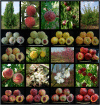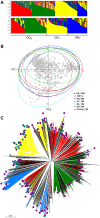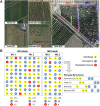The Multisite PeachRefPop Collection: A True Cultural Heritage and International Scientific Tool for Fruit Trees
- PMID: 32727910
- PMCID: PMC7536698
- DOI: 10.1104/pp.19.01412
The Multisite PeachRefPop Collection: A True Cultural Heritage and International Scientific Tool for Fruit Trees
Abstract
Plants have evolved a range of adaptive mechanisms that adjust their development and physiology to variable external conditions, particularly in perennial species subjected to long-term interplay with the environment. Exploiting the allelic diversity within available germplasm and leveraging the knowledge of the mechanisms regulating genotype interaction with the environment are crucial to address climatic challenges and assist the breeding of novel cultivars with improved resilience. The development of multisite collections is of utmost importance for the conservation and utilization of genetic materials and will greatly facilitate the dissection of genotype-by-environment interaction. Such resources are still lacking for perennial trees, especially with the intrinsic difficulties of successful propagation, material exchange, and living collection maintenance. This work describes the concept, design, and realization of the first multisite peach (Prunus persica) reference collection (PeachRefPop) located across different European countries and sharing the same experimental design. Other than an invaluable tool for scientific studies in perennial species, PeachRefPop provides a milestone in an international collaborative project for the conservation and exploitation of European peach germplasm resources and, ultimately, as a true heritage for future generations.
© 2020 American Society of Plant Biologists. All Rights Reserved.
Figures







References
-
- Badenes ML, Cambra M, López MM, Batlle I, Iglesias I, Aranzana MJ, López E E, Vives C C, Garcia Brunton J, et al. (2015) A peach germplasm collection for increasing the genetic diversity in European breeding programs. Acta Hortic 1084: 125–129
-
- Badenes ML, Martínez-Calvo J, Llácer G(1998) Analysis of peach germplasm from Spain. Acta Hortic 465: 243–250

